Business Management: Structure, Functions, Interrelation & Culture
VerifiedAdded on 2023/06/11
|10
|2282
|348
Report
AI Summary
This report provides an analysis of the management of a business entity, focusing on how different business functions interrelate with each other, using Tesco PLC as a case study. It covers management structure, business functions (including production, R&D, and marketing), and management functions (planning, organizing, commanding, coordinating, and controlling), detailing their roles, responsibilities, and interrelations. The report also explores the role of HR and talent management, including responsibilities like employee training, compensation, and compliance. Finally, it discusses organizational culture, highlighting clan and hierarchical cultures, and the impact of strong versus weak cultures on innovation and employee satisfaction. The report concludes that effective management involves integrating these functions to achieve organizational goals efficiently.
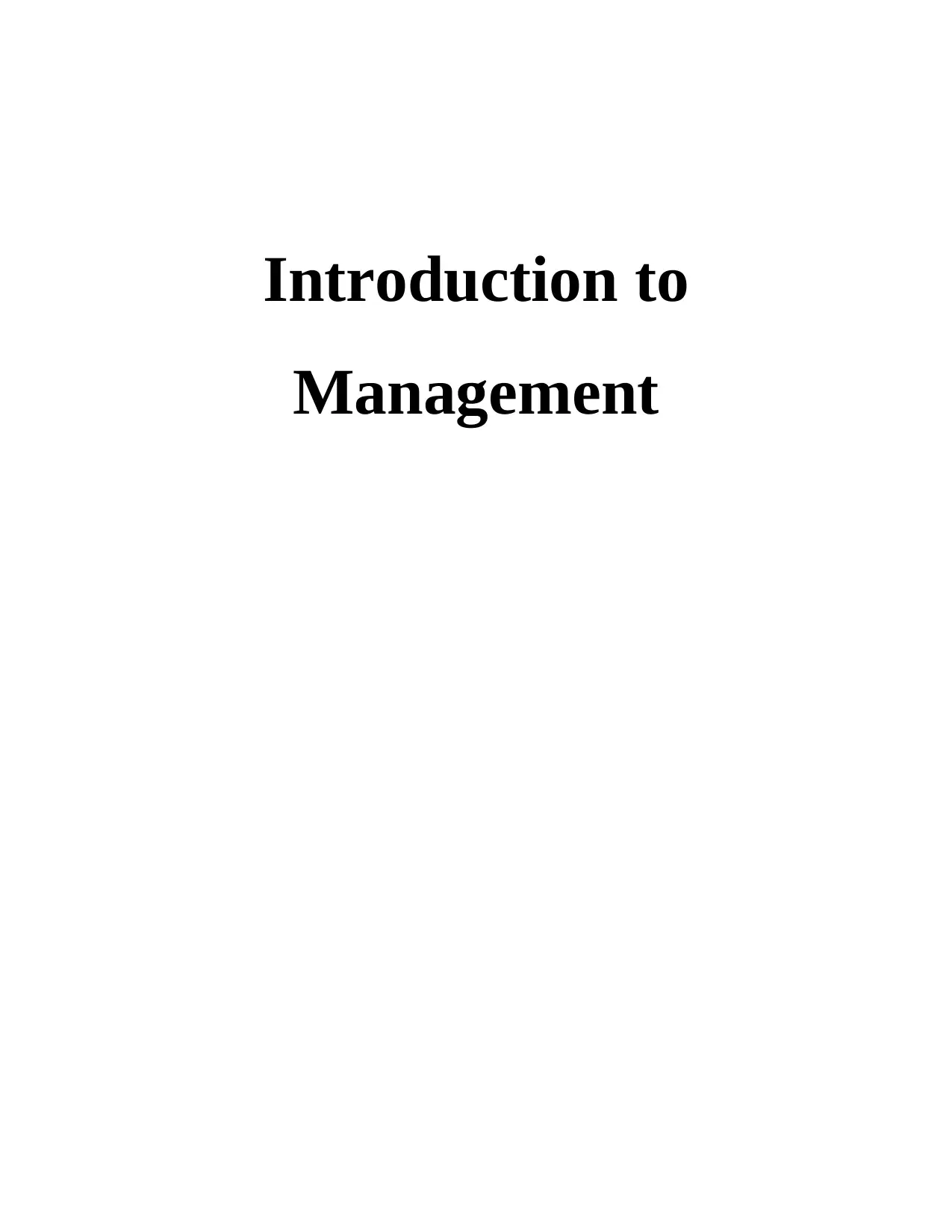
Introduction to
Management
Management
Paraphrase This Document
Need a fresh take? Get an instant paraphrase of this document with our AI Paraphraser
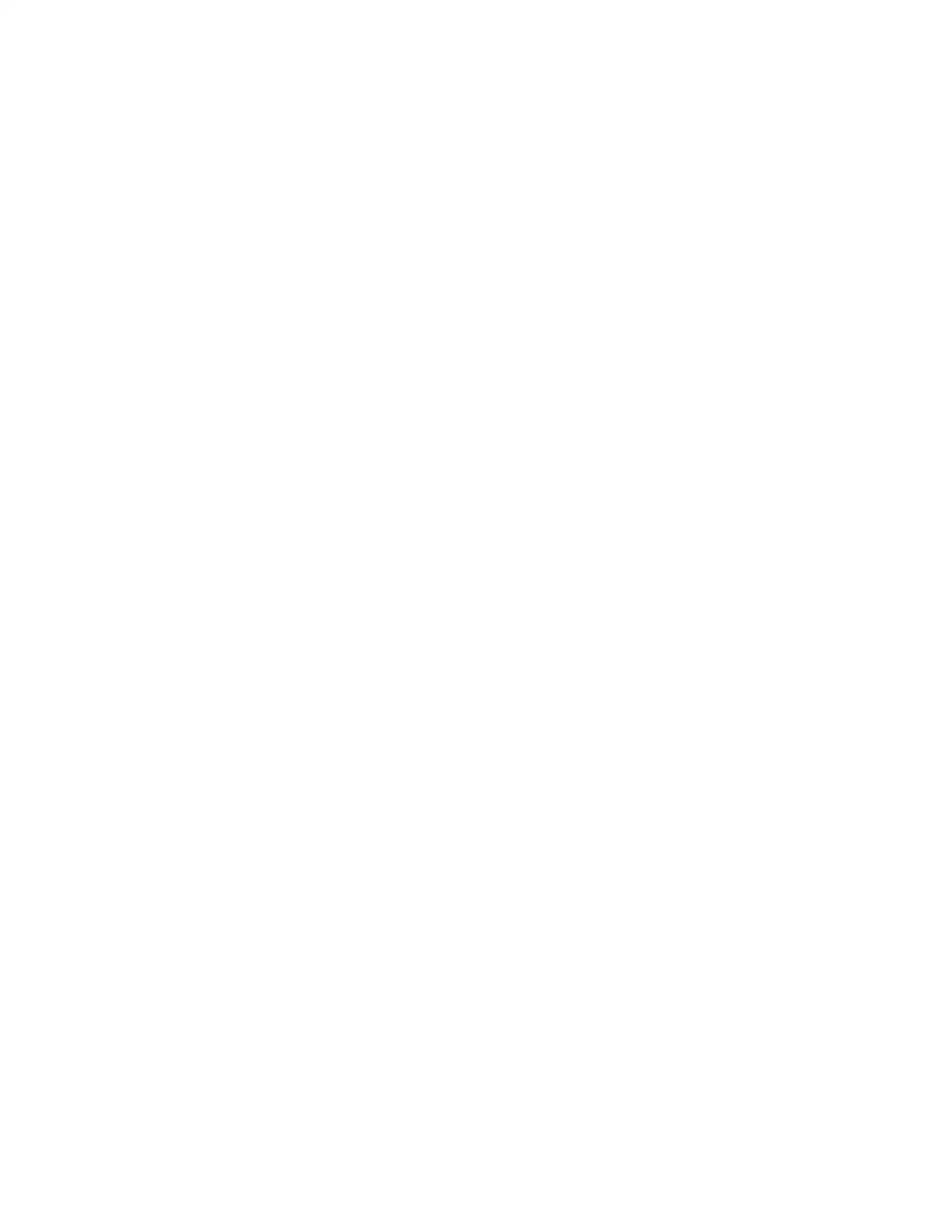

Contents
INTRODUCTION...........................................................................................................................................3
MAIN BODY.................................................................................................................................................3
Management structure and business function........................................................................................3
Business Function....................................................................................................................................4
Management function.............................................................................................................................5
Interrelation of management functions..................................................................................................6
Marketing function..................................................................................................................................7
HR and talent management.....................................................................................................................7
Organizational culture.............................................................................................................................8
CONCLUSION...............................................................................................................................................8
REFERENCES................................................................................................................................................9
INTRODUCTION...........................................................................................................................................3
MAIN BODY.................................................................................................................................................3
Management structure and business function........................................................................................3
Business Function....................................................................................................................................4
Management function.............................................................................................................................5
Interrelation of management functions..................................................................................................6
Marketing function..................................................................................................................................7
HR and talent management.....................................................................................................................7
Organizational culture.............................................................................................................................8
CONCLUSION...............................................................................................................................................8
REFERENCES................................................................................................................................................9
⊘ This is a preview!⊘
Do you want full access?
Subscribe today to unlock all pages.

Trusted by 1+ million students worldwide
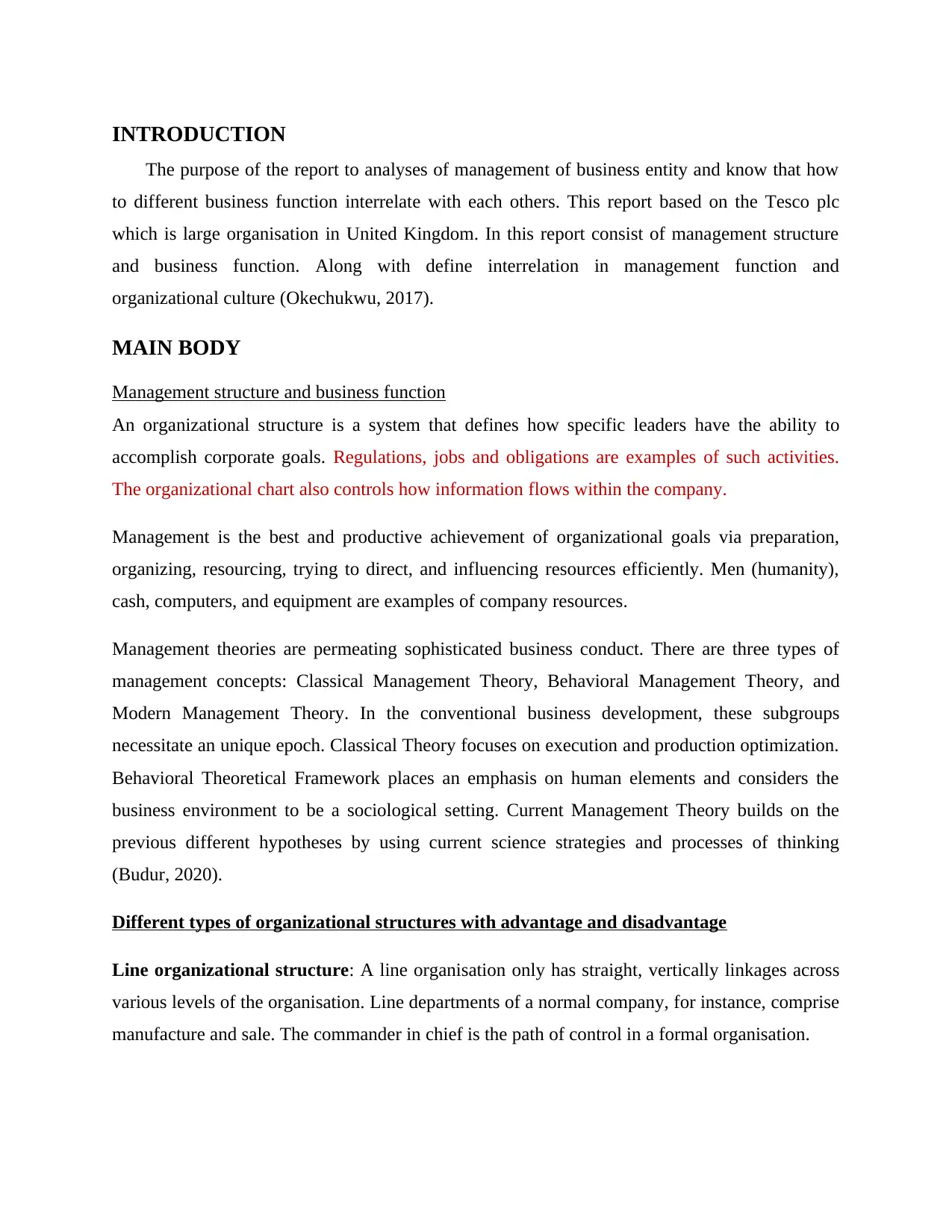
INTRODUCTION
The purpose of the report to analyses of management of business entity and know that how
to different business function interrelate with each others. This report based on the Tesco plc
which is large organisation in United Kingdom. In this report consist of management structure
and business function. Along with define interrelation in management function and
organizational culture (Okechukwu, 2017).
MAIN BODY
Management structure and business function
An organizational structure is a system that defines how specific leaders have the ability to
accomplish corporate goals. Regulations, jobs and obligations are examples of such activities.
The organizational chart also controls how information flows within the company.
Management is the best and productive achievement of organizational goals via preparation,
organizing, resourcing, trying to direct, and influencing resources efficiently. Men (humanity),
cash, computers, and equipment are examples of company resources.
Management theories are permeating sophisticated business conduct. There are three types of
management concepts: Classical Management Theory, Behavioral Management Theory, and
Modern Management Theory. In the conventional business development, these subgroups
necessitate an unique epoch. Classical Theory focuses on execution and production optimization.
Behavioral Theoretical Framework places an emphasis on human elements and considers the
business environment to be a sociological setting. Current Management Theory builds on the
previous different hypotheses by using current science strategies and processes of thinking
(Budur, 2020).
Different types of organizational structures with advantage and disadvantage
Line organizational structure: A line organisation only has straight, vertically linkages across
various levels of the organisation. Line departments of a normal company, for instance, comprise
manufacture and sale. The commander in chief is the path of control in a formal organisation.
The purpose of the report to analyses of management of business entity and know that how
to different business function interrelate with each others. This report based on the Tesco plc
which is large organisation in United Kingdom. In this report consist of management structure
and business function. Along with define interrelation in management function and
organizational culture (Okechukwu, 2017).
MAIN BODY
Management structure and business function
An organizational structure is a system that defines how specific leaders have the ability to
accomplish corporate goals. Regulations, jobs and obligations are examples of such activities.
The organizational chart also controls how information flows within the company.
Management is the best and productive achievement of organizational goals via preparation,
organizing, resourcing, trying to direct, and influencing resources efficiently. Men (humanity),
cash, computers, and equipment are examples of company resources.
Management theories are permeating sophisticated business conduct. There are three types of
management concepts: Classical Management Theory, Behavioral Management Theory, and
Modern Management Theory. In the conventional business development, these subgroups
necessitate an unique epoch. Classical Theory focuses on execution and production optimization.
Behavioral Theoretical Framework places an emphasis on human elements and considers the
business environment to be a sociological setting. Current Management Theory builds on the
previous different hypotheses by using current science strategies and processes of thinking
(Budur, 2020).
Different types of organizational structures with advantage and disadvantage
Line organizational structure: A line organisation only has straight, vertically linkages across
various levels of the organisation. Line departments of a normal company, for instance, comprise
manufacture and sale. The commander in chief is the path of control in a formal organisation.
Paraphrase This Document
Need a fresh take? Get an instant paraphrase of this document with our AI Paraphraser
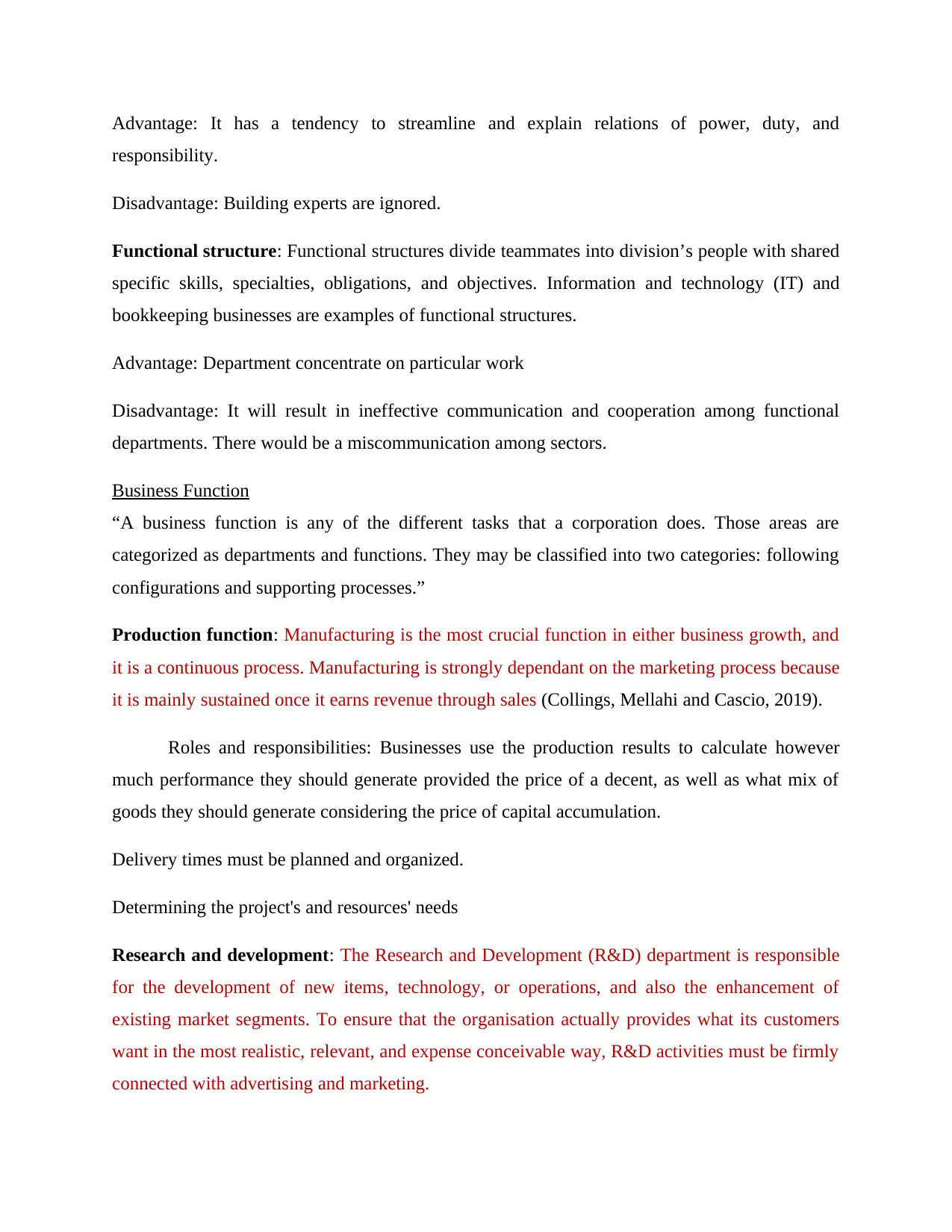
Advantage: It has a tendency to streamline and explain relations of power, duty, and
responsibility.
Disadvantage: Building experts are ignored.
Functional structure: Functional structures divide teammates into division’s people with shared
specific skills, specialties, obligations, and objectives. Information and technology (IT) and
bookkeeping businesses are examples of functional structures.
Advantage: Department concentrate on particular work
Disadvantage: It will result in ineffective communication and cooperation among functional
departments. There would be a miscommunication among sectors.
Business Function
“A business function is any of the different tasks that a corporation does. Those areas are
categorized as departments and functions. They may be classified into two categories: following
configurations and supporting processes.”
Production function: Manufacturing is the most crucial function in either business growth, and
it is a continuous process. Manufacturing is strongly dependant on the marketing process because
it is mainly sustained once it earns revenue through sales (Collings, Mellahi and Cascio, 2019).
Roles and responsibilities: Businesses use the production results to calculate however
much performance they should generate provided the price of a decent, as well as what mix of
goods they should generate considering the price of capital accumulation.
Delivery times must be planned and organized.
Determining the project's and resources' needs
Research and development: The Research and Development (R&D) department is responsible
for the development of new items, technology, or operations, and also the enhancement of
existing market segments. To ensure that the organisation actually provides what its customers
want in the most realistic, relevant, and expense conceivable way, R&D activities must be firmly
connected with advertising and marketing.
responsibility.
Disadvantage: Building experts are ignored.
Functional structure: Functional structures divide teammates into division’s people with shared
specific skills, specialties, obligations, and objectives. Information and technology (IT) and
bookkeeping businesses are examples of functional structures.
Advantage: Department concentrate on particular work
Disadvantage: It will result in ineffective communication and cooperation among functional
departments. There would be a miscommunication among sectors.
Business Function
“A business function is any of the different tasks that a corporation does. Those areas are
categorized as departments and functions. They may be classified into two categories: following
configurations and supporting processes.”
Production function: Manufacturing is the most crucial function in either business growth, and
it is a continuous process. Manufacturing is strongly dependant on the marketing process because
it is mainly sustained once it earns revenue through sales (Collings, Mellahi and Cascio, 2019).
Roles and responsibilities: Businesses use the production results to calculate however
much performance they should generate provided the price of a decent, as well as what mix of
goods they should generate considering the price of capital accumulation.
Delivery times must be planned and organized.
Determining the project's and resources' needs
Research and development: The Research and Development (R&D) department is responsible
for the development of new items, technology, or operations, and also the enhancement of
existing market segments. To ensure that the organisation actually provides what its customers
want in the most realistic, relevant, and expense conceivable way, R&D activities must be firmly
connected with advertising and marketing.
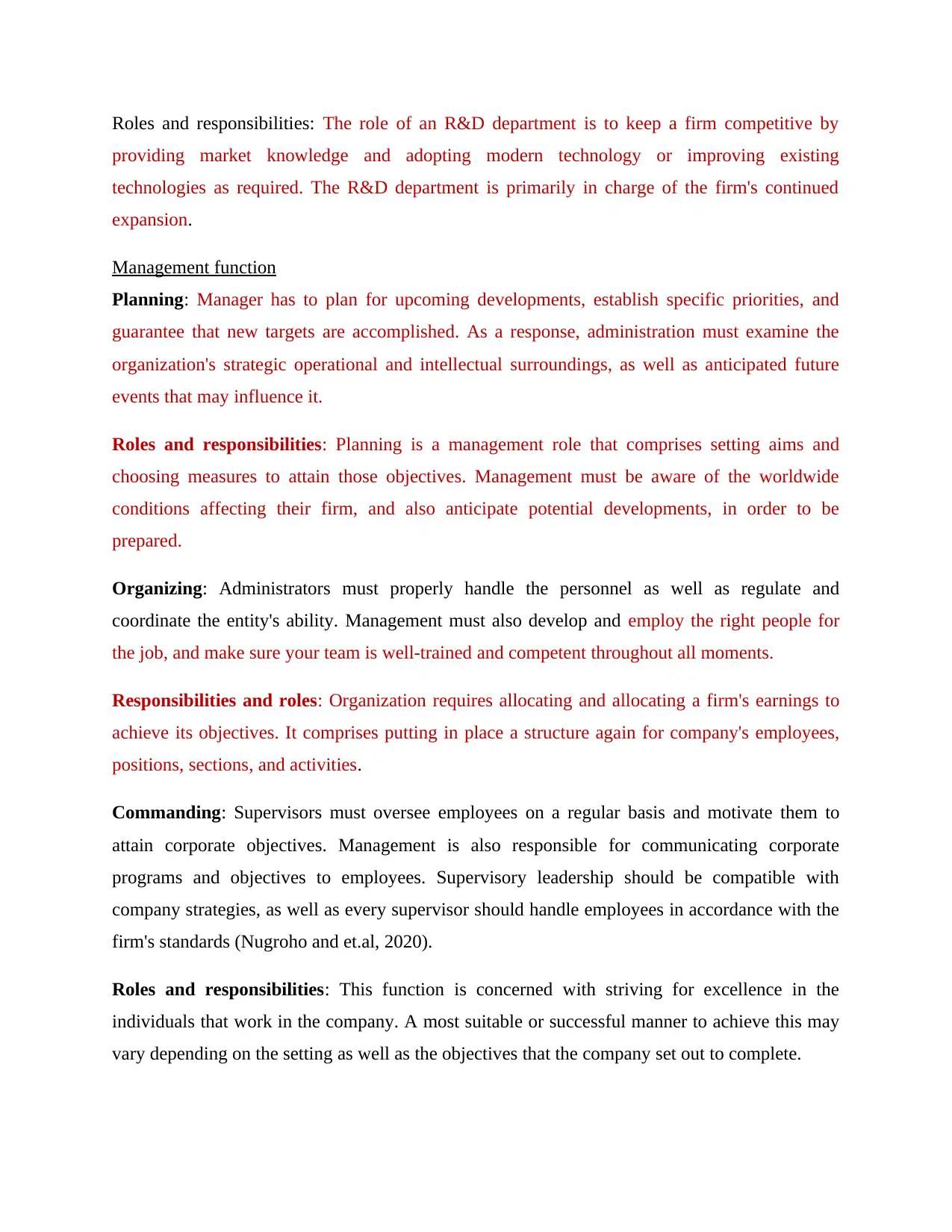
Roles and responsibilities: The role of an R&D department is to keep a firm competitive by
providing market knowledge and adopting modern technology or improving existing
technologies as required. The R&D department is primarily in charge of the firm's continued
expansion.
Management function
Planning: Manager has to plan for upcoming developments, establish specific priorities, and
guarantee that new targets are accomplished. As a response, administration must examine the
organization's strategic operational and intellectual surroundings, as well as anticipated future
events that may influence it.
Roles and responsibilities: Planning is a management role that comprises setting aims and
choosing measures to attain those objectives. Management must be aware of the worldwide
conditions affecting their firm, and also anticipate potential developments, in order to be
prepared.
Organizing: Administrators must properly handle the personnel as well as regulate and
coordinate the entity's ability. Management must also develop and employ the right people for
the job, and make sure your team is well-trained and competent throughout all moments.
Responsibilities and roles: Organization requires allocating and allocating a firm's earnings to
achieve its objectives. It comprises putting in place a structure again for company's employees,
positions, sections, and activities.
Commanding: Supervisors must oversee employees on a regular basis and motivate them to
attain corporate objectives. Management is also responsible for communicating corporate
programs and objectives to employees. Supervisory leadership should be compatible with
company strategies, as well as every supervisor should handle employees in accordance with the
firm's standards (Nugroho and et.al, 2020).
Roles and responsibilities: This function is concerned with striving for excellence in the
individuals that work in the company. A most suitable or successful manner to achieve this may
vary depending on the setting as well as the objectives that the company set out to complete.
providing market knowledge and adopting modern technology or improving existing
technologies as required. The R&D department is primarily in charge of the firm's continued
expansion.
Management function
Planning: Manager has to plan for upcoming developments, establish specific priorities, and
guarantee that new targets are accomplished. As a response, administration must examine the
organization's strategic operational and intellectual surroundings, as well as anticipated future
events that may influence it.
Roles and responsibilities: Planning is a management role that comprises setting aims and
choosing measures to attain those objectives. Management must be aware of the worldwide
conditions affecting their firm, and also anticipate potential developments, in order to be
prepared.
Organizing: Administrators must properly handle the personnel as well as regulate and
coordinate the entity's ability. Management must also develop and employ the right people for
the job, and make sure your team is well-trained and competent throughout all moments.
Responsibilities and roles: Organization requires allocating and allocating a firm's earnings to
achieve its objectives. It comprises putting in place a structure again for company's employees,
positions, sections, and activities.
Commanding: Supervisors must oversee employees on a regular basis and motivate them to
attain corporate objectives. Management is also responsible for communicating corporate
programs and objectives to employees. Supervisory leadership should be compatible with
company strategies, as well as every supervisor should handle employees in accordance with the
firm's standards (Nugroho and et.al, 2020).
Roles and responsibilities: This function is concerned with striving for excellence in the
individuals that work in the company. A most suitable or successful manner to achieve this may
vary depending on the setting as well as the objectives that the company set out to complete.
⊘ This is a preview!⊘
Do you want full access?
Subscribe today to unlock all pages.

Trusted by 1+ million students worldwide

Coordinating: Administrators must synchronies the firm's standard of practice, which means
that each action of each organizational structure should supplement and enhance the operation of
someone else.
Roles and responsibilities: It promotes spirit of cooperation among people, project teams, and
divisions, as well as cooperation in working in a dynamic and duties in order to effectively
accomplish organizational objectives.
Controlling: Administrators must verify that corporate activities are consistent with the
company's overarching goal and rules. This is also the team's responsibility to detect and
recognize deviation from the objectives and vision, and also to take action to correct different
behavior.
Roles and responsibilities: Control is a managerial position that assists in the discovery of
issues and the appropriate remedial actions. Those are all created to stop deviations from normal
and to ensure that the organization's main goals are met in the most efficient manner possible
(Buil, Martínez and Matute, 2019).
Interrelation of management functions
Planning with controlling function: Managing and organizing are tightly related. The goals of
the company are established via planned, and they are realized through management. The
management sequence is defined by intended outcomes, and regulating provides a firm
framework for decision making. In truth, planning and controlling are mutually linked. For
instance, when a sales manager sets a goal of 5 million in revenue in one quarterly with five
salespeople on their group, he would assign an objective of 1 million to each sales people and
will oversee their activities to accomplish the necessary outcomes.
Plan with organizing function: Management must first formulate a plan then organize their
resources and assign duties to employees in line with the strategic objectives then train personnel
to maintain control over the strategic approach, and afterwards review the proposal's
effectiveness because it is being implemented and make any necessary changes. For example,
Assume Melissa, the marketing manager, has a target of growing sales in the month of February.
Melissa must first spend quality time outlining the measures she and her group of salespersons
must undertake in order to raise sales figures. Such measures could include raising marketing in
that each action of each organizational structure should supplement and enhance the operation of
someone else.
Roles and responsibilities: It promotes spirit of cooperation among people, project teams, and
divisions, as well as cooperation in working in a dynamic and duties in order to effectively
accomplish organizational objectives.
Controlling: Administrators must verify that corporate activities are consistent with the
company's overarching goal and rules. This is also the team's responsibility to detect and
recognize deviation from the objectives and vision, and also to take action to correct different
behavior.
Roles and responsibilities: Control is a managerial position that assists in the discovery of
issues and the appropriate remedial actions. Those are all created to stop deviations from normal
and to ensure that the organization's main goals are met in the most efficient manner possible
(Buil, Martínez and Matute, 2019).
Interrelation of management functions
Planning with controlling function: Managing and organizing are tightly related. The goals of
the company are established via planned, and they are realized through management. The
management sequence is defined by intended outcomes, and regulating provides a firm
framework for decision making. In truth, planning and controlling are mutually linked. For
instance, when a sales manager sets a goal of 5 million in revenue in one quarterly with five
salespeople on their group, he would assign an objective of 1 million to each sales people and
will oversee their activities to accomplish the necessary outcomes.
Plan with organizing function: Management must first formulate a plan then organize their
resources and assign duties to employees in line with the strategic objectives then train personnel
to maintain control over the strategic approach, and afterwards review the proposal's
effectiveness because it is being implemented and make any necessary changes. For example,
Assume Melissa, the marketing manager, has a target of growing sales in the month of February.
Melissa must first spend quality time outlining the measures she and her group of salespersons
must undertake in order to raise sales figures. Such measures could include raising marketing in
Paraphrase This Document
Need a fresh take? Get an instant paraphrase of this document with our AI Paraphraser

a certain location, selling some things, expanding the number of needed client rep interaction, or
revisiting existing clients to see whether they are keen to buy other goods.
Marketing function
The following is a statement of the interconnectedness between sales activities and other
organizational functions: Different sections and functional units are connected to each other if
marketing tactics are not used. It may be characterized as advertising mediums that rely on the
assistance of the company's existing operational sections to work efficiently. Whenever a
business organisation must establish and create marketing, the firm's accounting department,
training and development, salesman, and project manager will be required to help (Khan and
Abdullah, 2019).
The advertising department receives sufficient funding from the finance department to
make smart marketing decisions. The manufacturing company communicates with the
fulfillment center to ensure that all products are available when needed. Human resource policies
are guidelines in reaction to market trends, revenues, and future market opportunities. As a
consequence, every one of the company's operational parts collaborates to develop a successful
marketing campaign across the board.
HR and talent management
Role of HR: A HR department's job is to motivation and performance while also protecting the
company from every difficulty that occurs in the course. HR responsibilities include salaries and
bonuses, hiring, and releasing employees, and also remaining current on any rules that may
influence the company and its employees.
Responsibilities: Responsibilities in human capital involve educating new employers must ensure
they comprehend corporate policies. They can accomplish this through developing or revising
employee retention guidebooks, as well as organizing and hosting working population
workshops to clarify modifications in incentives or policies. Discontinuing workers is another
painful aspect of their HR department's job. To accomplish this, firm HR personnel must grasp
relevant labor regulations and execute the procedure thoughtfully and professionally.
revisiting existing clients to see whether they are keen to buy other goods.
Marketing function
The following is a statement of the interconnectedness between sales activities and other
organizational functions: Different sections and functional units are connected to each other if
marketing tactics are not used. It may be characterized as advertising mediums that rely on the
assistance of the company's existing operational sections to work efficiently. Whenever a
business organisation must establish and create marketing, the firm's accounting department,
training and development, salesman, and project manager will be required to help (Khan and
Abdullah, 2019).
The advertising department receives sufficient funding from the finance department to
make smart marketing decisions. The manufacturing company communicates with the
fulfillment center to ensure that all products are available when needed. Human resource policies
are guidelines in reaction to market trends, revenues, and future market opportunities. As a
consequence, every one of the company's operational parts collaborates to develop a successful
marketing campaign across the board.
HR and talent management
Role of HR: A HR department's job is to motivation and performance while also protecting the
company from every difficulty that occurs in the course. HR responsibilities include salaries and
bonuses, hiring, and releasing employees, and also remaining current on any rules that may
influence the company and its employees.
Responsibilities: Responsibilities in human capital involve educating new employers must ensure
they comprehend corporate policies. They can accomplish this through developing or revising
employee retention guidebooks, as well as organizing and hosting working population
workshops to clarify modifications in incentives or policies. Discontinuing workers is another
painful aspect of their HR department's job. To accomplish this, firm HR personnel must grasp
relevant labor regulations and execute the procedure thoughtfully and professionally.
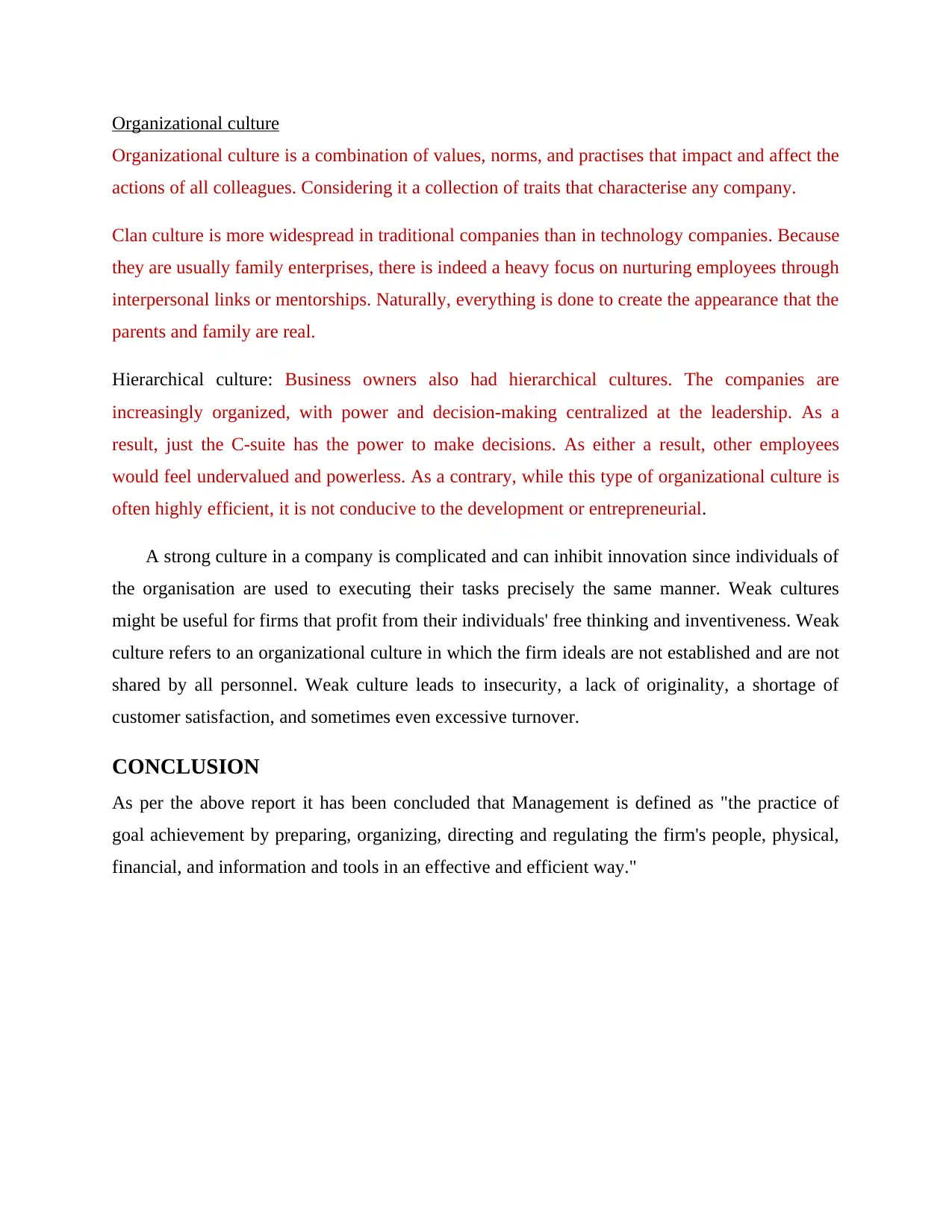
Organizational culture
Organizational culture is a combination of values, norms, and practises that impact and affect the
actions of all colleagues. Considering it a collection of traits that characterise any company.
Clan culture is more widespread in traditional companies than in technology companies. Because
they are usually family enterprises, there is indeed a heavy focus on nurturing employees through
interpersonal links or mentorships. Naturally, everything is done to create the appearance that the
parents and family are real.
Hierarchical culture: Business owners also had hierarchical cultures. The companies are
increasingly organized, with power and decision-making centralized at the leadership. As a
result, just the C-suite has the power to make decisions. As either a result, other employees
would feel undervalued and powerless. As a contrary, while this type of organizational culture is
often highly efficient, it is not conducive to the development or entrepreneurial.
A strong culture in a company is complicated and can inhibit innovation since individuals of
the organisation are used to executing their tasks precisely the same manner. Weak cultures
might be useful for firms that profit from their individuals' free thinking and inventiveness. Weak
culture refers to an organizational culture in which the firm ideals are not established and are not
shared by all personnel. Weak culture leads to insecurity, a lack of originality, a shortage of
customer satisfaction, and sometimes even excessive turnover.
CONCLUSION
As per the above report it has been concluded that Management is defined as "the practice of
goal achievement by preparing, organizing, directing and regulating the firm's people, physical,
financial, and information and tools in an effective and efficient way."
Organizational culture is a combination of values, norms, and practises that impact and affect the
actions of all colleagues. Considering it a collection of traits that characterise any company.
Clan culture is more widespread in traditional companies than in technology companies. Because
they are usually family enterprises, there is indeed a heavy focus on nurturing employees through
interpersonal links or mentorships. Naturally, everything is done to create the appearance that the
parents and family are real.
Hierarchical culture: Business owners also had hierarchical cultures. The companies are
increasingly organized, with power and decision-making centralized at the leadership. As a
result, just the C-suite has the power to make decisions. As either a result, other employees
would feel undervalued and powerless. As a contrary, while this type of organizational culture is
often highly efficient, it is not conducive to the development or entrepreneurial.
A strong culture in a company is complicated and can inhibit innovation since individuals of
the organisation are used to executing their tasks precisely the same manner. Weak cultures
might be useful for firms that profit from their individuals' free thinking and inventiveness. Weak
culture refers to an organizational culture in which the firm ideals are not established and are not
shared by all personnel. Weak culture leads to insecurity, a lack of originality, a shortage of
customer satisfaction, and sometimes even excessive turnover.
CONCLUSION
As per the above report it has been concluded that Management is defined as "the practice of
goal achievement by preparing, organizing, directing and regulating the firm's people, physical,
financial, and information and tools in an effective and efficient way."
⊘ This is a preview!⊘
Do you want full access?
Subscribe today to unlock all pages.

Trusted by 1+ million students worldwide
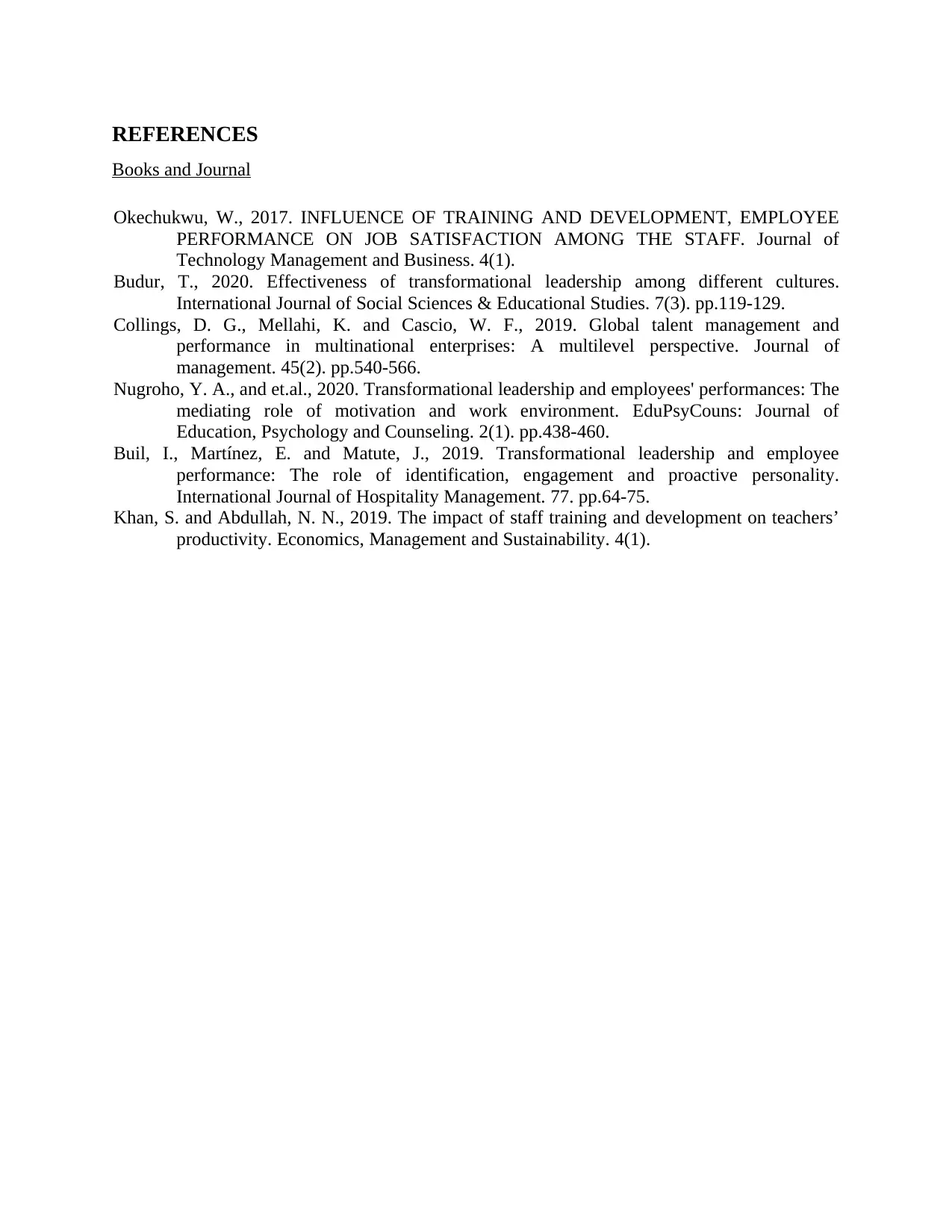
REFERENCES
Books and Journal
Okechukwu, W., 2017. INFLUENCE OF TRAINING AND DEVELOPMENT, EMPLOYEE
PERFORMANCE ON JOB SATISFACTION AMONG THE STAFF. Journal of
Technology Management and Business. 4(1).
Budur, T., 2020. Effectiveness of transformational leadership among different cultures.
International Journal of Social Sciences & Educational Studies. 7(3). pp.119-129.
Collings, D. G., Mellahi, K. and Cascio, W. F., 2019. Global talent management and
performance in multinational enterprises: A multilevel perspective. Journal of
management. 45(2). pp.540-566.
Nugroho, Y. A., and et.al., 2020. Transformational leadership and employees' performances: The
mediating role of motivation and work environment. EduPsyCouns: Journal of
Education, Psychology and Counseling. 2(1). pp.438-460.
Buil, I., Martínez, E. and Matute, J., 2019. Transformational leadership and employee
performance: The role of identification, engagement and proactive personality.
International Journal of Hospitality Management. 77. pp.64-75.
Khan, S. and Abdullah, N. N., 2019. The impact of staff training and development on teachers’
productivity. Economics, Management and Sustainability. 4(1).
Books and Journal
Okechukwu, W., 2017. INFLUENCE OF TRAINING AND DEVELOPMENT, EMPLOYEE
PERFORMANCE ON JOB SATISFACTION AMONG THE STAFF. Journal of
Technology Management and Business. 4(1).
Budur, T., 2020. Effectiveness of transformational leadership among different cultures.
International Journal of Social Sciences & Educational Studies. 7(3). pp.119-129.
Collings, D. G., Mellahi, K. and Cascio, W. F., 2019. Global talent management and
performance in multinational enterprises: A multilevel perspective. Journal of
management. 45(2). pp.540-566.
Nugroho, Y. A., and et.al., 2020. Transformational leadership and employees' performances: The
mediating role of motivation and work environment. EduPsyCouns: Journal of
Education, Psychology and Counseling. 2(1). pp.438-460.
Buil, I., Martínez, E. and Matute, J., 2019. Transformational leadership and employee
performance: The role of identification, engagement and proactive personality.
International Journal of Hospitality Management. 77. pp.64-75.
Khan, S. and Abdullah, N. N., 2019. The impact of staff training and development on teachers’
productivity. Economics, Management and Sustainability. 4(1).
1 out of 10
Related Documents
Your All-in-One AI-Powered Toolkit for Academic Success.
+13062052269
info@desklib.com
Available 24*7 on WhatsApp / Email
![[object Object]](/_next/static/media/star-bottom.7253800d.svg)
Unlock your academic potential
Copyright © 2020–2025 A2Z Services. All Rights Reserved. Developed and managed by ZUCOL.



